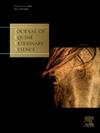The associations between dismount semen evaluation, post-mating antibiotics, and mare clinical parameters
IF 1.3
3区 农林科学
Q2 VETERINARY SCIENCES
引用次数: 0
Abstract
In-hand-mating is the only acceptable method of breeding Thoroughbred mares; confirmation of ejaculation and monitoring of semen quality is performed via dismount samples collected from the mare's cranial vagina or, more typically, from the glans penis of the stallion after mating. Also, in-hand-mating poses significant challenges, such as transmitting venereal and infectious diseases; thus, strategies to minimize such issues include screening for infectious diseases and post-mating uterine infusion of antibiotics such as ceftiofur or ticarcillin. This study aimed to determine associations dismount sample features and mare clinical parameters during in-hand-mating. The study involved 50 matings of 25 mares and three fertile stallions. Ovulation was induced with GnRH-agonist (Histrelin acetate), and mares were mated 24h later under the maiden-mare-sedation protocol (100 mg xylazine, 10 mg butorphanol, 20 mg acepromazine, all-intravenous). Uterine cultures and cytology were performed 4h, 3d, and 5d after mating. Dismount semen samples were assessed for volume, concentration and semen kinetics using a portable sperm analyzer (iSpermⓇ). Mares underwent daily transrectal ultrasonography for six days post-mating to confirm ovulation and detect uterine fluid. Uterine infusions were performed 4 h post-mating and then q24-h for 5 d immediately after each ultrasonography. Each mare underwent a control cycle (60 mL LRS/infusion, 25 cycles) followed by an antibiotic cycle (ceftiofur reconstituted in distilled water 20 mL+ 40 mL of LRS, n=15 cycles or 3.1 of ticarcillin-clavulanate reconstituted in distilled water 20 mL+ 40 mL of LRS, 10 cycles) for five infusions. No other post-mating therapies were applied. Pregnancy was confirmed 14d post-ovulation and then terminated with dinoprost (7.5 mg, intramuscularly). Data were analyzed using generalized linear mixed models (GLMM) with significance set at P<0.05. All mares ovulated 24 h post-GnRH-application. Dismount parameters did not vary between control and ceftiofur (12.1 ± 5 mL and 11.7 ± 4.4 mL gel free volume; 71.7 ± 3.71 and 78.4 ± 3.6 total motility; 61.1 ± 8.3, and 66.7 ± 5.8 progressive motility, respectively) groups (P<0.05) or between ticarcillin and control (12.3±4.8 and 11.2±5.5 mL gel free; 73.7 ± 5.27% and, 70.1± 4.8% total motility; 65.5±6.8%, and 62.6±8.1% progressive motility, respectively) groups (P>0.05). Uterine infusions of ceftiofur or ticarcillin reduced endometrial leukocyte counts compared to their respective controls (P<0.05). Mares receiving antibiotics had fewer uterine infections (40.5%) than the control (54.2%) 72h post-mating (P<0.05). Intrauterine fluid accumulation varied over time (P<0.05) but not with groups or interactions (P>0.05). The group overall affected the pregnancy rate (P<0.05; antibiotic 36% vs. 54% control). There was an effect of the group for ceftiofur (P < 0.05; ceftiofur 25% vs. 75% control) but no effect of the group for ticarcillin (ticarcillin 56.6% vs. 43.3% control; P > 0.05) for pregnancy rates. In conclusion, there was no association between dismount samples and mare clinical parameters. Despite apparent satisfactory semen parameters and lower leukocyte counts post-mating in antibiotics-treated cycles, fertility was low.
求助全文
约1分钟内获得全文
求助全文
来源期刊

Journal of Equine Veterinary Science
农林科学-兽医学
CiteScore
2.70
自引率
7.70%
发文量
249
审稿时长
77 days
期刊介绍:
Journal of Equine Veterinary Science (JEVS) is an international publication designed for the practicing equine veterinarian, equine researcher, and other equine health care specialist. Published monthly, each issue of JEVS includes original research, reviews, case reports, short communications, and clinical techniques from leaders in the equine veterinary field, covering such topics as laminitis, reproduction, infectious disease, parasitology, behavior, podology, internal medicine, surgery and nutrition.
 求助内容:
求助内容: 应助结果提醒方式:
应助结果提醒方式:


